4 Days in Rome: How to Plan an Amazing Rome Itinerary
Wondering exactly how to spend 4 days in Rome? Or maybe you have more or less time and you’re trying to figure out how to plan an unforgettable Rome itinerary. Either way, you’re in the right place. We have each been to Rome multiple times – including a full ten days in 2021 – and have put all of our tips, tricks, and discoveries into this guide to help you plan an amazing trip, especially if it’s your first time.
We recently spent three months in Europe – the longest trip we can take on a tourist visa as Americans – and were astounded how often we heard about the Romans as we traveled around Spain and Portugal (not to mention Italy).
Everywhere we went, we found remnants of Ancient Rome, from temples to excavated ruins and city walls. In fact, many Spanish cities like Barcelona were founded by the Romans, though they obviously look very, very different today.
One of the things I find most interesting about Rome is the contrast between the elements of Ancient Roman history, which is perhaps the most well-known empire in human history (at least the most “well-known” in modern times), and the fact that Italy as a nation is relatively young.
One of the youngest in Europe, in fact. Italy didn’t become a sovereign nation until the mid 19th Century despite regions within its current borders being immensely important for two millennia, give or take.
Both Alysha and I have been to Rome multiple times before. In fact, I loved Rome so much after my first trip with family post-college-graduation that I did the exact same trip two years later, this time with friends. Alysha lived in Rome for six months in college, calling the more residential part of Prati, the neighborhood near the Vatican, home.
In 2021, we spent 10 days in Rome, split into two five day visits, and we fell in love with the city all over again. After that trip, we have almost completely re-written this guide to reflect our discoveries on that latest visit in hopes that you, like us, will fall in love with the city that has had such a profound impact on human history.
In this guide to planning your trip to Rome, you’ll find a detailed 4 day Rome itinerary, complete with things to do, see, eat, and drink, along with the important details you need to know like how to see the Colosseum and when to walk around the historic center to get that photo of Trevi Fountain without all the people.
You’ll also find logistics – like how to get around and the best time to visit – that are important for planning your trip.
We hope you enjoy this guide, that you find it helpful for planning your trip, and we help you discover something new and exciting, whether it’s your first time, or tenth.


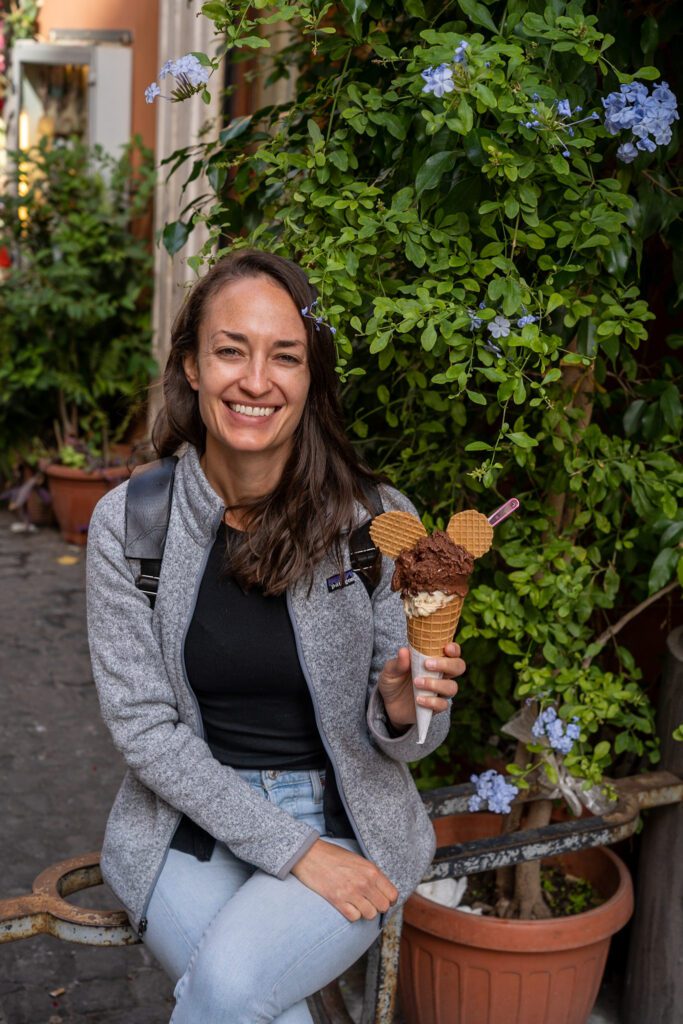
Disclaimer: Some of the links in this post, like hotel links, are affiliate links, meaning at no additional cost to you, we make a little bit of money if you click through and book. That being said, we would never recommend something to you that we don’t stand behind 100%.
How Many Days in Rome?
Given the amount to do and see in the city, we think that 4 days in Rome is the absolute minimum you should plan for to avoid spending your entire trip running around from sight to sight without time to savor the atmosphere of the city and enjoy the dolce vita that makes Italy so special.
With four days, you’ll comfortably be able to fit in the Vatican, Colosseum, and Borghese Gallery alongside eating pizza and pasta, drinking plenty of wine, and exploring a few of our favorite neighborhoods (and getting some pretty magnificent views of Rome along the way).
Our biggest tip for planning a trip to Rome is to not do more than one major sight (e.g. the Colosseum, Vatican, or Borghese Gallery) on the same day.
Each of those places is going to take a lot of energy, and by the time you’re getting ready to go to the second one, you’re going to be exhausted and the experience isn’t going to be nearly as enjoyable.
If you have two or three days in Rome, it’s still doable. Below the main itinerary, we have our thoughts on how to spend one, two, and three days in Rome to help you plan a trip with less time.
Where to Stay in Rome
There are a wide variety of options in terms of accommodations in Rome, and which you choose is largely going to depend on your style and budget.
Which is why we’ve put together a detailed guide to help you decide where to stay in Rome, which has our favorite neighborhoods along with pros/cons and highlights for each. For more detail, head over and read that.
Here’s the short version.
- Our overall recommendation is to find a charming hotel or guesthouse in Trastevere, which is far and away our favorite part of Rome. Cobblestone streets, energetic piazzas, and some of the best bars and restaurants in Rome? Sign me up! We stayed at Horti 14 Borgo on our last trip, a gorgeous boutique hotel just outside of the center of Trastevere, and really enjoyed it. Especially the breakfast buffet.
- If it’s your first time in Rome, you can’t go wrong with the Centro Storico. Stay at Casa Pietra or Coronari Palace if you’re looking for a hotel or guesthouse. We stayed at these apartments on our latest trip, and they were almost perfect.
- If you’re looking for a slightly different experience, look at Monti, a hip part of Rome that’s near the Colosseum and Forum, and is packed full of bars, restaurants, cafes, and more. It’s a good central location, and generally feels much younger than, say, the Centro Storico.
You can find the long version over in our more detailed guide to where to stay in Rome.
4 Days in Rome: A Complete Guide to Planning Your 4 Day Rome Itinerary
Over the course of 4 days in Rome, you’ll marvel at the achievements of Ancient Rome, see some of the best art collections in the entire world, and delight in what modern Rome has to offer, like great wine bars, restaurants, and more.
Here’s an overview of the itinerary you’ll find below:
- Day 1: The Colosseum & Roman Forum + Your First Aperitivo
- Day 2: The Vatican, St. Peter’s Basilica, and Castel Sant’Angelo
- Day 3: Self-Guided Centro Storico Walk + The Borghese Gallery
- Day 4: Explore Two of Rome’s Best Neighborhoods
Day 1: The Colosseum & Roman Forum + Your First Aperitivo
Start your day where it all began – in the heart of Ancient Rome. Take the majority of the day to wrap your head around the centuries of history where this little quarter of the city played an outsized role, then spend the afternoon and evening experiencing aperitivo.
The Colosseum and Roman Forum
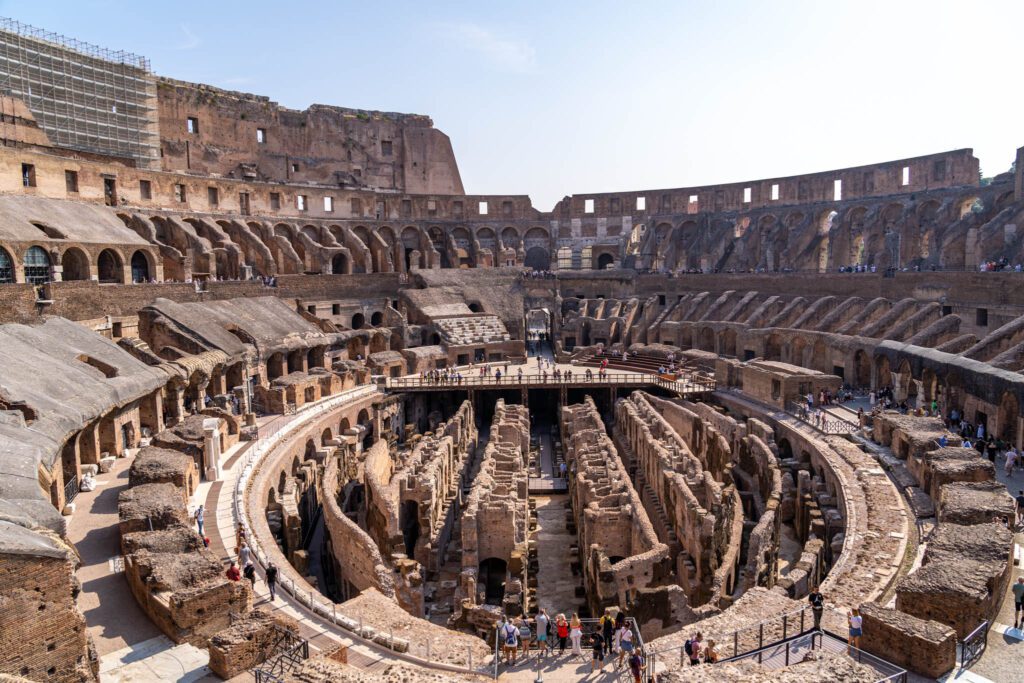
For all intents and purposes, these two sights should be grouped together. They represent similar periods in Roman history, they’re adjacent to each other, and they’re visited on the same ticket or tour.
Before or after your tour, there’s an excellent view of the Roman Forum from OUTSIDE the boundaries located here.
It’s well worth heading up and over the hill to Piazza del Campidoglio (with a replica of a famous Michelangelo statue in the middle) and Piazza Venezia, which houses the Altar of the Fatherland dedicated to Italy’s first king after unification, Vittorio Emanuele II.
The Colosseum (or the Flavian Amphitheater)
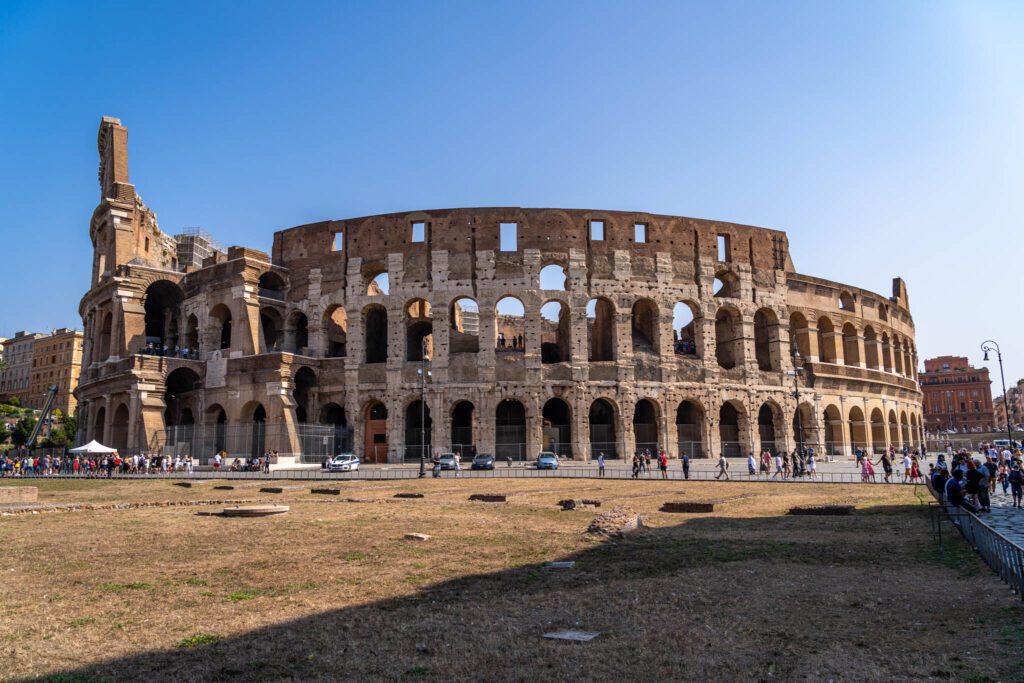
The Colosseum is the massive Roman amphitheater, the most well-known (and biggest) in the world. The structure was commissioned by Emperor Vespasian in 72 C.E. after the area was used as a private palace for infamous (and unpopular) Emperor Nero. It was kind of a gesture to the people that the ruling class hadn’t forgotten them.
Unfortunately, Vespasian didn’t live to see it completed. Instead, it was completed under his son Titus in 80 C.E., taking just eight years to build (which is insane when you consider that some churches take several centuries).
It’s most likely that the building, after some expansions and renovations over the years, could fit somewhere between 40,000 and 50,000 spectators, though you’ll still hear numbers as high as 80,000 thrown around which most historians agree is a little aggressive.
Another misconception about the Colosseum that is mostly perpetuated by media like movies and TV shows is that the gladiatorial games were brutal, bloody, and murderous.
That’s true to an extent, but our guide reminded us that, at the end of the day, the gladiators were highly skilled professionals AND they were the property of rich people who most definitely didn’t want their assets killed.
It’s more likely that the gladiatorial battles were similar to modern-day boxing matches than the bloodbaths you’ve seen Russell Crowe participate in.
They’ve reconstructed part of the wooden floor of the arena, and below that you can see the intricate series of cages, tunnels, and staging areas where gladiators and exotic animals were kept before being brought up onto the stage using an innovative elevator system.
It’s massive, and it’s an incredible feat of human ingenuity. I, Matt, have done the Colosseum four different times now, and each time my jaw hits the floor as you emerge onto the platform around the edge of the arena.
The Roman Forum
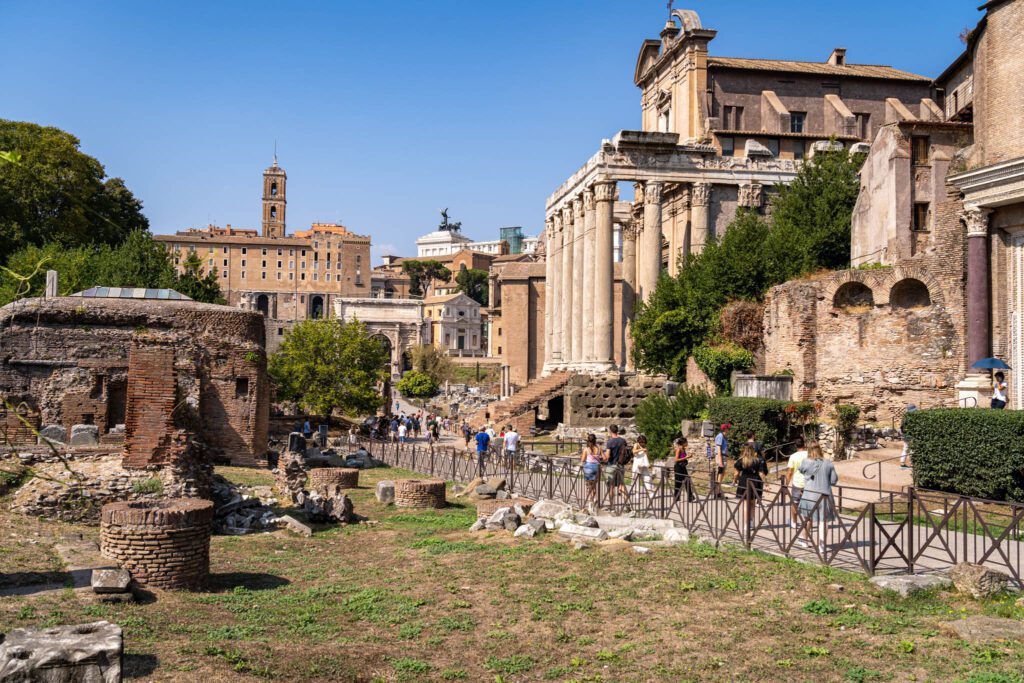
The Roman Forum – known in Italian as the Foro Romano – is a little different than the Colosseum. Unlike the Colosseum, which stands tall and intact (having been rebuilt and renovated over the years), the Roman Forum is mostly ruins.
Which makes it hard to understand what you’re looking at without a guide to help you decipher the difference between the Senate building and the Temple of the Vestal Virgins. Palatine Hill, one of the seven hills of Rome, is just to the southwest and is accessible from within the complex (you’ll find one of the best views in Rome from the viewpoint at the top).
The majority of the important buildings in Ancient Rome were within walking distance of this historic meeting place.
Contrary to popular belief, while there is a temple dedicated to Julius Caesar here, he was actually not killed in the Forum, but over near Largo di Torre Argentina.

How to Visit the Colosseum and Roman Forum
Like I mentioned above, I have done the Colosseum and Forum four different times now – twice with a guided tour, twice on my own – and I can say without a doubt that the Colosseum and Roman Forum are best experienced with a guided tour.
Specifically, a guided tour with someone who knows what they’re talking about, which is exactly what you’re going to get with Walks of Italy.
We did this Walks of Italy tour on this most recent trip to Rome, and we were blown away by the knowledge, richness, and detail that our guide – Dario – brought to the experience for us.
He busted all sorts of myths that we had fully believed to be true, and was able to weave together a cohesive story throughout the three hour tour that had us engaged the entire time.
And keep in mind, we had both experienced it already more than once before!
We highly, highly recommend booking a guided tour for the Colosseum and Forum. If you only have time for one guided tour in Rome, this should be the one.
Especially because the Forum is really just a bunch of crumbled buildings on the surface, and you need the history and context from a guide to really kick your imagination into overdrive and envision how this area might have looked when it was the beating heart of the Roman Empire.
If you’re not quite sure about a tour, read about our experience with the Walks of Italy Colosseum tour.

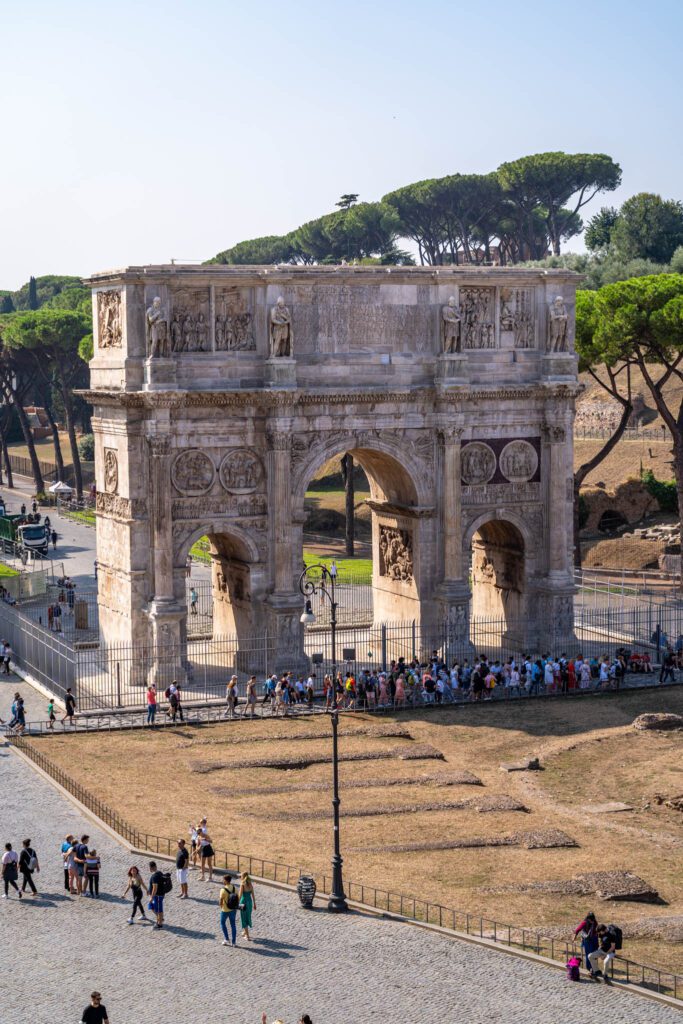
Visiting the Colosseum and Forum Independently
You, of course, can visit independently. We would suggest purchasing the audio guide, or downloading the Rick Steves audio guide ahead of your visit. It’s not going to be as interactive or interesting as a tour, but it will give you some of the context around what you’re looking at.
Buy your tickets in advance, and as far in advance as possible if you’re coming to Rome in the summer.
For more information and to buy tickets, go to the official website (we’re not giving you exact hours and ticket prices because they do change, and it’s better to just go to the official site to check them in real time).
You’re going to need at least three to four hours to do them both justice. Even in late September, exploring the Roman Forum was HOT. In the summertime, it will be borderline unbearable with very limited opportunities for shade and a brief respite from the sun. Bring plenty of water and sunscreen, you will need both.
Afterwards, take a well-earned break and grab lunch, head back to the hotel and relax, and get ready for a late afternoon walk up to one of the best viewpoints in Rome.
The Orange Garden and Keyhole
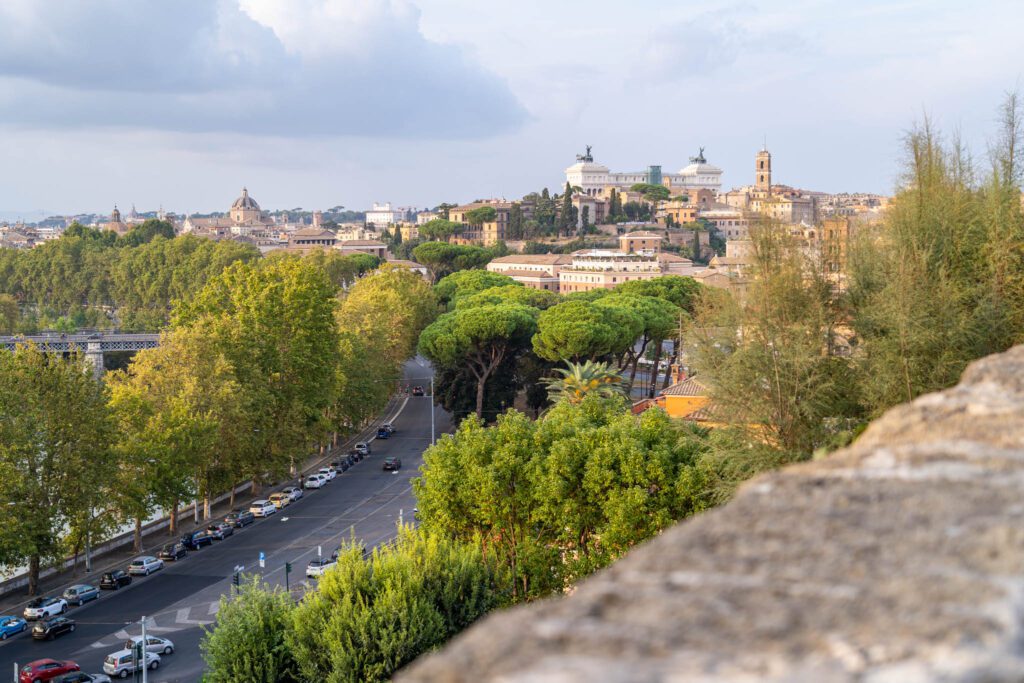
Post-nap, it’s time to get back out there and explore a bit more. This time, head to the Orange Garden (here on Google Maps) , which is perched on a hill with great views of Rome and the Vatican.
Another worthwhile stop just a few hundred feet away is the keyhole (here on Google Maps), which is a now-Insta-famous spot where you can look through, well, a keyhole, that has the dome of the Vatican perfectly framed. I say it’s Insta-famous, because if you’re here in peak season in the afternoon, you’re likely going to have to wait in line for the privilege of looking through said keyhole.
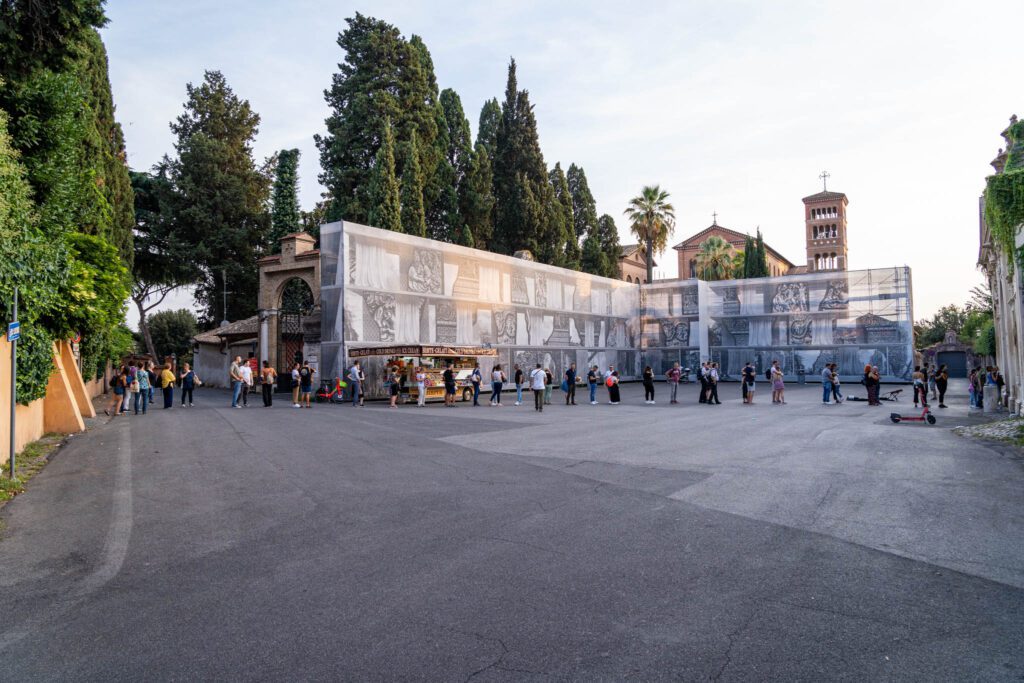
An alternative would be to do this part of the itinerary in the morning before the Colosseum, which is a vastly different experience. Instead of kids and tourists coming up to watch the sunset, the area is packed full of locals walking their dogs. And there was not a single person waiting to look through the keyhole, just us!
Your First Aperitivo
Aperitivo is a period during the late afternoon, between getting off work and dinner time (which is later than you’d expect in Rome) where people go out for drinks. And those drinks are served with a selection of small bites, like bruschetta, olives, and things like that.
If you’re American or Canadian, it’s a little like happy hour, except the food is complimentary with your drinks. While the days of full-on aperitivo buffets are behind us, at least in most of Rome, the idea behind aperitivo is still one of our favorite parts about spending time in Rome.
During aperitivo, our drink of choice (and what you’ll see many people drinking) is the Aperol Spritz. It’s a light cocktail – perfect for a summer day – that is made with sparkling water, sparkling wine (all of the bubbles, please!) and Aperol, an orange-colored bitter aperitif.
The spritz is usually 4-5 Euros (definitely don’t pay more than 6 Euros!), and is the quintessential aperitivo beverage to us. I made the mistake of ordering a Campari Spritz instead, just to try it, and won’t be doing it again. It was fine, totally drinkable if you’re into bitter liqueurs like Campari, but it wasn’t nearly as refreshing.
Anyway, after the orange garden, you’re in the perfect position to head to our favorite aperitivo spot in Rome – Zerosettantacinque – which is near where the Circus Maximus (a huge chariot racing track) used to be, which fits perfectly with the Ancient Rome theme of today.

The location is great, the drinks are good, and they bring you a little selection of bites to go with your drinks (and have a bigger menu of food, if you’re still hungry).
Dinner and Drinks in Monti

After a spritz or two, head into nearby Monti, the hip neighborhood on the northern side of the Colosseum, for dinner.
I say hip because there are multiple record shops and vintage clothing stores on one of the streets, which is a clear sign that the kids hang out there (by “the kids” I’m referring to 20-somethings wearing bell bottom light wash jeans and those glasses with thin wire frames and big lenses that look like Harry Potter’s glasses).
We walked through here a couple of times at various times of day. After dark is, by far, the most lively time to be here.
Grab dinner at either Cimarra Pizza and Cocktails or Al Vino Al Vino, and indulge in your first gelato of the trip at Fatamorgana, one of our favorite gelato shops in Rome with rotating seasonal flavors and fresh ingredients.
P.S.: We loved this piece on how to spot “good” gelato. Spoiler: the gelato with super bright colors that is spilling out of the tubs outside the shop near Trevi Fountain is, unsurprisingly, not the best you can find.
More Rome Travel Guides to Help You Plan Your Trip
- ITINERARY: How to Plan an Amazing Rome Itinerary
- WHERE TO STAY: The Best Places to Stay in Rome
- COLOSSEUM TOUR: Our Favorite Colosseum Tour in Rome (Review)
- GLUTEN FREE: Gluten Free Restaurants in Rome
Day 2: The Vatican, St. Peter’s Basilica, and Castel Sant’Angelo
On your second day, tackle the second world-famous attraction in Rome, the Vatican. Home to the Sistine Chapel and St. Peter’s Basilica, the Vatican is fascinating even if you’re not really religious. It’s an impressive collection of art, with the crown jewel being the Sistine Chapel.
A word on fashion for this day, not because we want to make sure you’re as stylish as possible, but because the Vatican is a religious site. That means your shoulders and knees should be covered up, even if it’s blistering hot in the summer.
Otherwise you may not be able to enter certain parts of the complex, namely St. Peter’s Basilica.
But First, Coffee

Before your trip to the Vatican, head to Pergamino Caffè for some of the best coffee in Rome. I’m a coffee lover, particularly if I get to choose which coffee is used to make my coffee, and this is the perfect place for that.
They have coffee roasters from all over Europe, heavily focused on Italian roasters, and will prepare you a cup of great coffee, whether you’re into lattes or filter coffee.
It’s on the south side of the Vatican, just around the corner from the main entrance to the Museums, which makes it a perfect spot pre-Vatican.
The Vatican and St. Peter’s Basilica
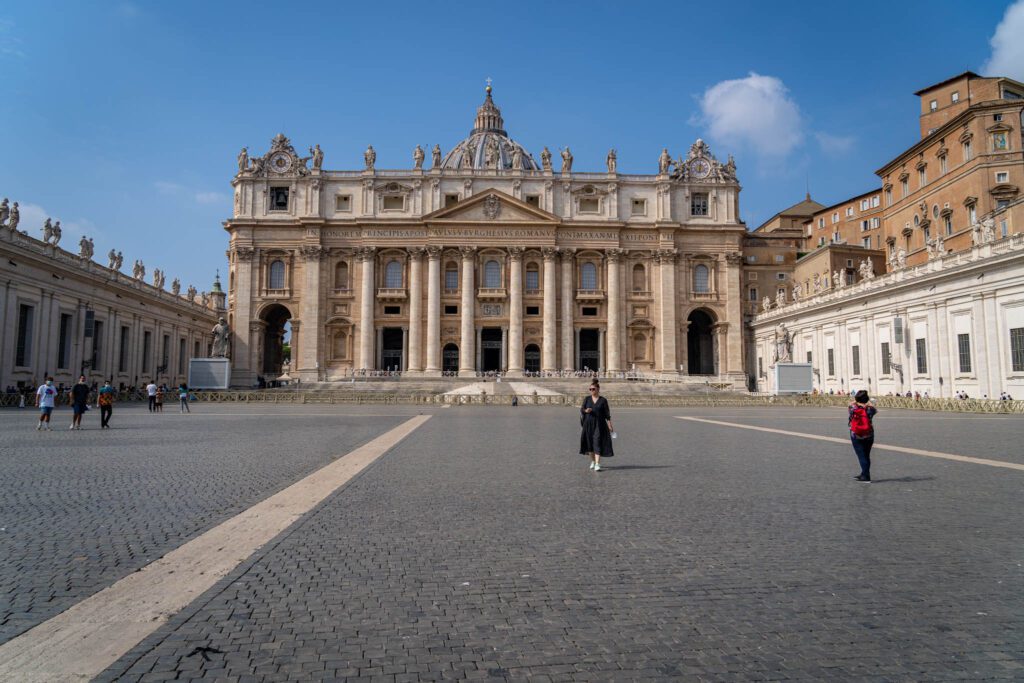
Arguably the most famous museum in the world makes its home in the collections of the Vatican. They show a whopping 20,000 pieces of art and culminate with the legendary Sistine Chapel, where the ceiling frescos bear the work of Michelangelo.
One contradiction that always pops up in the back of my mind when visiting huge, ornate churches has to do with the role of the church.
Why, you might ask, does an organization that preaches the Bible, which unequivocally condemns rich people who do not give away their wealth, have such an ornate and over-the-top display of wealth? Great question to ask the Pope, if you run into him (or her, in case you’re reading this at a time when we’ve gotten a female pope).
As a religious site, I have questions about the Vatican and St. Peter’s Basilica. If you put those questions aside for a second and just consider it as a collection of art, it’s a pretty incredible display featuring a who’s who of Italian art history.
There are essentially two pieces – the Vatican Museums (which include the Sistine Chapel) and St. Peter’s Basilica. You should visit both, and you should try to be either on the first or last tour of the day (obviously, the way we have it written would have you here for the first tour of the day).

Buy tickets here – toggle the site to English with the language selector in the top right.
For the best experience, we’d recommend either picking the tickets that include an audioguide, or, even better, book a guided tour that includes a live guide.
We’d go with the “Pristine Sistine” tour with Walks of Italy (have we mentioned that we really like them?), which gets you into the Museums an hour before they open to the public, when you at least have a shot at experiencing the magic of the Sistine Chapel before it’s packed wall-to-wall with smelly, loud tourists, which can really ruin the vibes.
Lunch in Prati
After the Vatican and St Peter’s Basilica, head into Prati, the neighborhood immediately adjacent to the Vatican, for lunch.
This is the part of Rome that Alysha called home for six months in college (albeit a more residential part of the neighborhood a ways away from the Vatican), and it’s a little bit more upscale and family oriented than other parts of the city center.
However, despite being so close to a tourist attraction – which is usually a bad sign in terms of food quality and value – there are some truly outstanding places to eat here.
If you’re looking for the best pizza-by-the-slice in Rome, go to Bonci Pizzarium, a tiny hole-in-the-wall where you’ll find a daily selection of rectangular pizzas served in rectangular slices, which is different from what you might get in the US. Pizza toppings rotate all the time.
I went here with friends years ago, and unfortunately the whole “gluten free” thing is a major problem in this case, so we didn’t go back this last time.
If you’re sick of Italian food (really? On day two?), we LOVED El Maiz, a Venezuelan restaurant serving arepas, cachapas, and tostones.

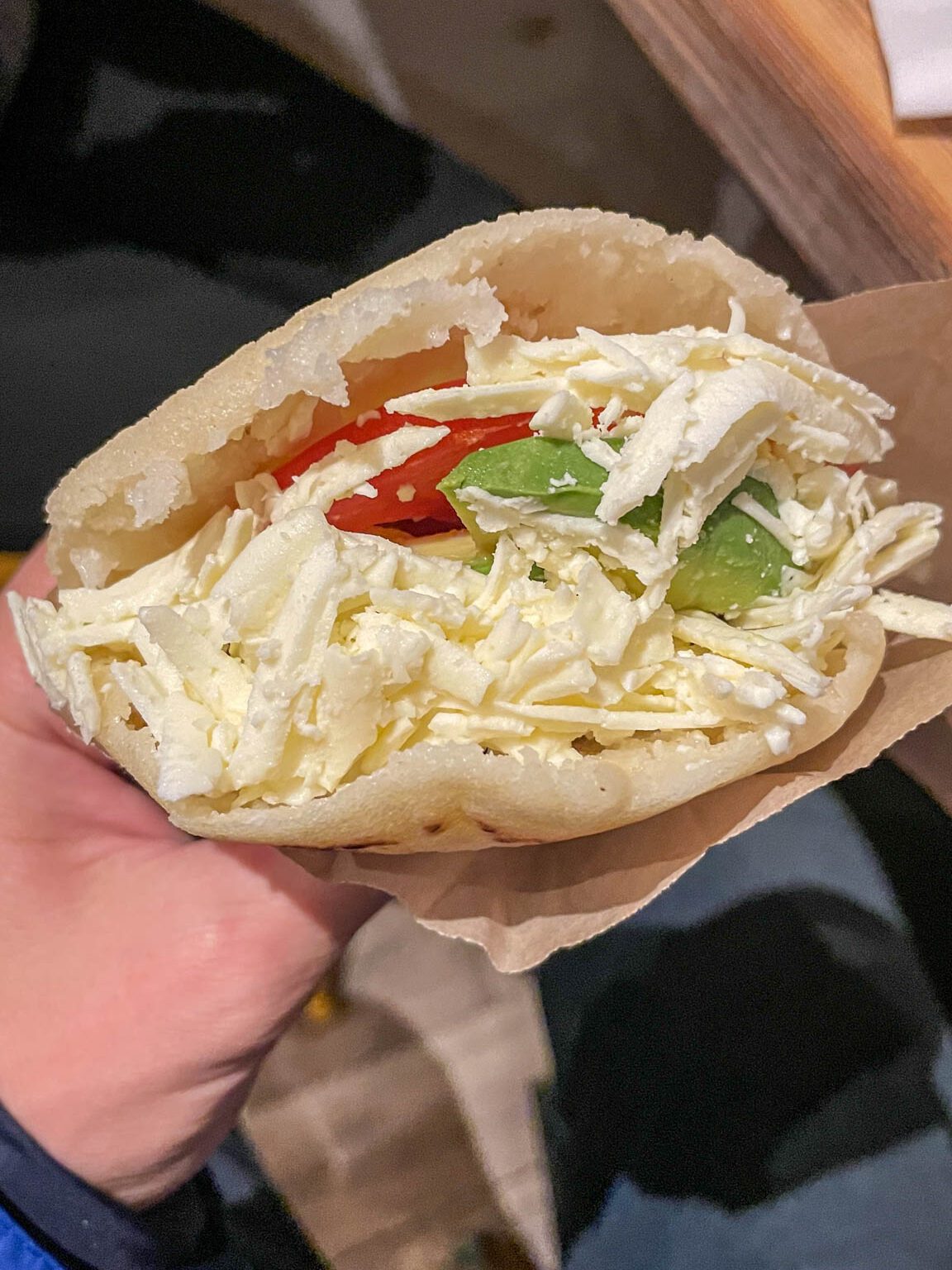
We love Venezuelan arepas, and were pleasantly surprised to find them in Rome. The tostones – fried green plantains with toppings – here are spectacular, and were among the best things we ate in Rome. Although the queso cachapa (kind of like a sweet corn crepe stuffed with about a pound of cheese) is delicious too.
Castel Sant’Angelo
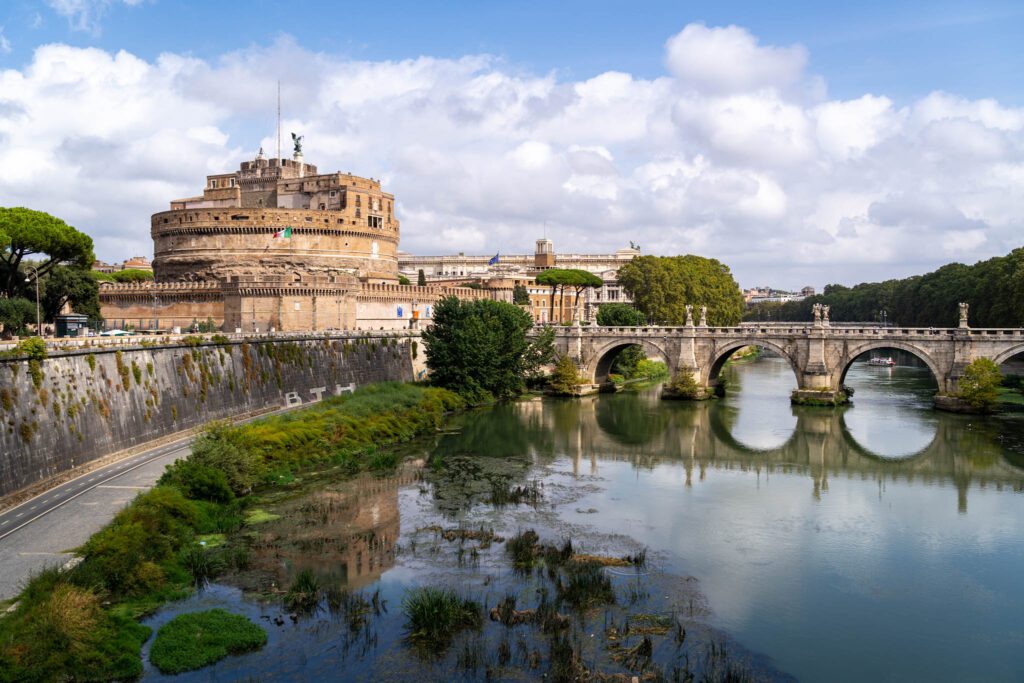
After lunch, make your way towards the river to Castel Sant’Angelo , which is a place that we ordinarily would have skipped, but found ourselves doing on day 8 or 9 because we had plenty of time to fit it in.
It was built by the Roman Emperor Hadrian as a mausoleum, and then the Catholic Church grabbed it and turned it into a fortress. Today, it’s part art museum, part abandoned castle with some cool art installations inside.
It’s a bit expensive to get in – 14 Euros at the time of writing – but we enjoyed it. The best part, by far, is the terrace on top, which has a lovely view of the Vatican.
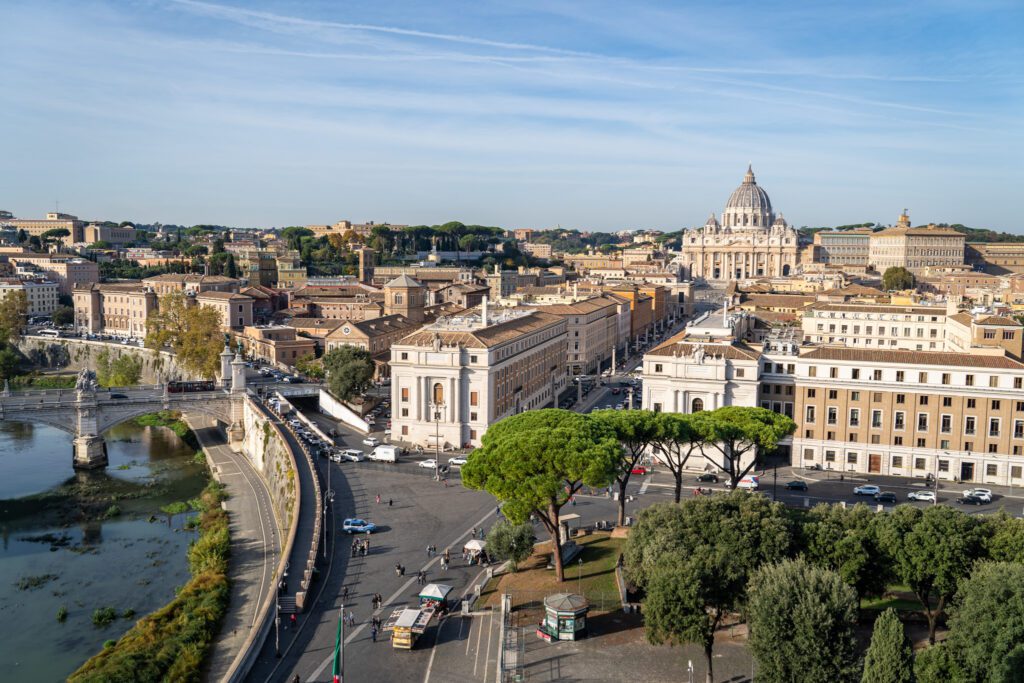
Buy your tickets in advance – especially in 2021 and beyond when attendance is limited. We didn’t and ended up waiting a bit because the timeslot at the beginning of the day was sold out.
The view from the other side of the bridge directly in front of Castel Sant’Angelo is also spectacular. If you decide not to go inside, definitely make sure to head to the other end of that bridge (and give a firm “no, grazie” to all of the people trying to sell you various things as you cross the bridge).
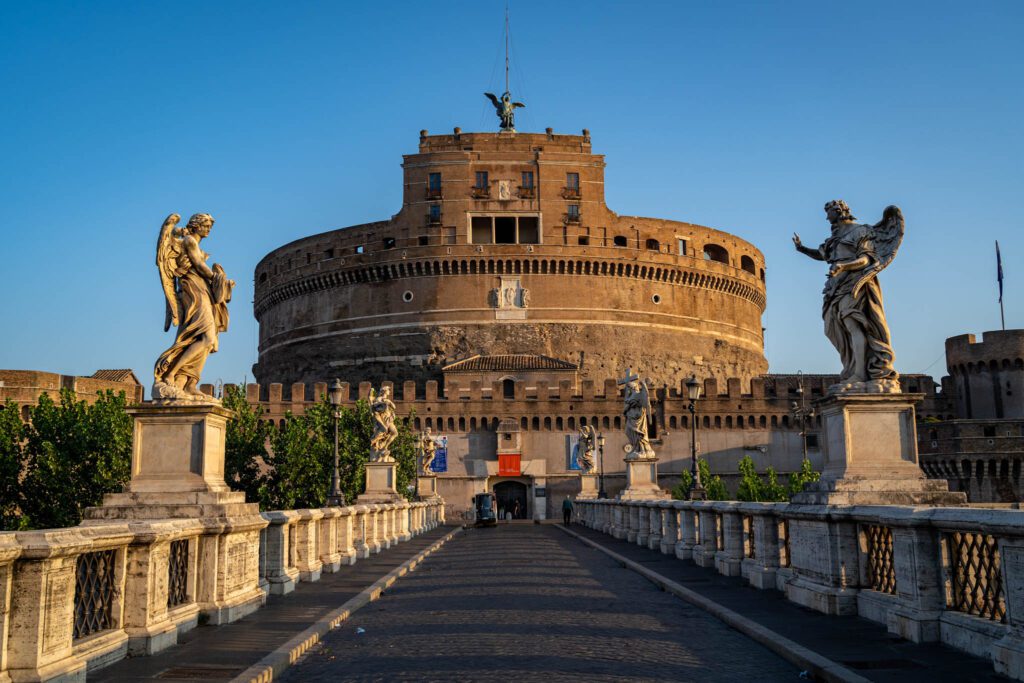
That photo spot is roughly here on Google Maps, and that picture was taken at 8:00 am, before the bulk of the tourists showed up.
Our Favorite Wine Bar in Rome
When in Rome, drink good wine. And our favorite wine in Rome came from Enoteca Il Piccolo, a charming little wine bar in the Centro Storico known for a rotating selection of natural wines from local producers.
Not only was the wine – specifically a pet-nat, lightly bubbly white wine – great, but the experience was unique too! For context, we speak minimal Italian – enough to get by, order food, and pay, but that’s about it.

I attempted to describe, in Italian, what kind of wine I wanted (Alysha went straight for the bubbles – CLASSIC!), and it was a little bit of a disaster. An older gentleman, who I believe was the owner, was helping me, and he took my attempt, turned around, left, and brought me back a great glass of wine that perfectly matched what I was hoping for. All with about ten words spoken between us.
They have a nice little terrace outside that is a great place for a glass of wine on a warm afternoon, and sell wine by the bottle if you want to get one to enjoy later.
Dinner in the Centro Storico
After you’ve enjoyed some Italian wine, it’s time to dive into the best part about Rome – the food! In the Centro Storico, you’ve got a lot of options, but they generally get worse the closer you get to popular places like Trevi Fountain and Campo de’ Fiori, so we’d recommend picking a place around a few blocks from those main spots if you can.
For what it’s worth, we really enjoyed Pantha Rei, a restaurant tucked away on an alley near the Pantheon with gluten free (and gluten-full) options. You can see the Pantheon from their outdoor terrace.
Roscioli Salumeria con Cucina is one of the most highly rated restaurants in Rome – make a reservation if you want to eat here! This is our top pick based on recommendations from locals (though, for gluten reasons, we didn’t eat there ourselves) if you are able to get a table.
Post-dinner, get gelato at either Grom (our favorite gelato in Rome) or Frigidarium, probably the most famous gelato shop in the world.
Here’s a guide to eating in Rome that we really enjoyed, despite not being able to eat at 95% of the places she recommends (plus, if you’re truly a foodie, you should probably do one of her food / walking tours).
Day 3: Self-Guided Centro Storico Walk + The Borghese Gallery
Today, pick yourself up out of bed as early as you can to make it to the Centro Storico before it’s flooded with tourists, then spend a leisurely afternoon exploring the Villa Borghese and taking in the most popular art museum in Rome – the Borghese Gallery.
Cap it off with a foodie experience – either a cooking class or a food walking tour – to dive deep into the food culture of Rome and try some amazing bites from local spots you probably wouldn’t discover on your own.
An Early Morning Self-Guided Walk of the Centro Storico
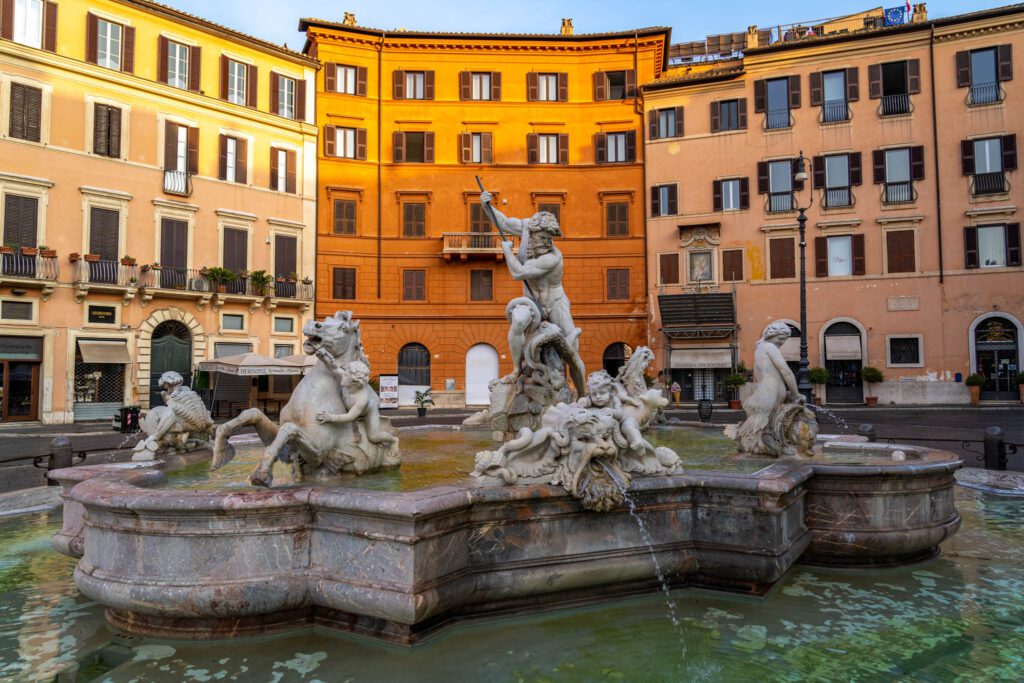
As we mentioned above, you’ll want to get out to start this walk before 9:00 am. At the very latest. Otherwise, this entire route is just packed wall-to-wall with people at basically any other time of day.
Follow a route roughly northeast from Campo de’ Fiori to the Spanish Steps, ending at Piazza del Popolo.
Here’s a handy map of this route, along with the stops mentioned.
- Piazza Navona – This vast square is built atop an ancient stadium (hence the shape). It’s a pandemonium affair, with trattorias and wine bars spilling onto the uneven cobblestones. The Fontana dei Quattro Fiumi (by Gian Lorenzo Bernini, no less) looks especially wonderful at night, as does the Fontana di Nettuno at the north end of the square.
- Campo de’ Fiori – A flower / produce market by day that also has some of the most tasteless souvenirs imaginable (don’t buy souvenirs here), this is a perfect spot to start your exploration of Rome’s city center.
- The Pantheon – Once a Roman temple, now a Catholic church, the Pantheon has a mighty imperial façade that was rebuilt in the 2nd century AD. The great rotunda inside has a hole in the roof that lets in a solitary beam of sunlight, sometimes illuminating the tomb of the revered artist Raphael. There can be huge lines to get in later in the day, another reason to get up early!
- Trevi Fountain – They say you’ll return to Rome if you throw a coin in the Trevi Fountain. Good luck getting close enough to do that. The spot is always packed with crowds, even early in the morning, but it’s still an iconic sight that’s famed for appearing in films like La Dolce Vita. Whatever you do, don’t eat nearby, where you’ll pay 50% more for 100% worse food.
- Spanish Steps – 135 steps of pure elegance await here. They’re an icon of Rome and link the Borghese Gardens to the Piazza di Spagna, where a gorgeous Baroque fountain by Pietro Bernini decorates the flagstones.
- Piazza del Popolo – Your final stop, this is where you’ll find the city’s oldest obelisk – the narrow tower in the middle of the square, inspired by the Egyptians – and the former northern gate of the city of Rome. However, the square isn’t nearly that old – it was actually designed in the 19th Century. Head up to the Terrazza del Pincio (here on Google Maps) for an incredible view of the square and St. Peter’s Basilica.
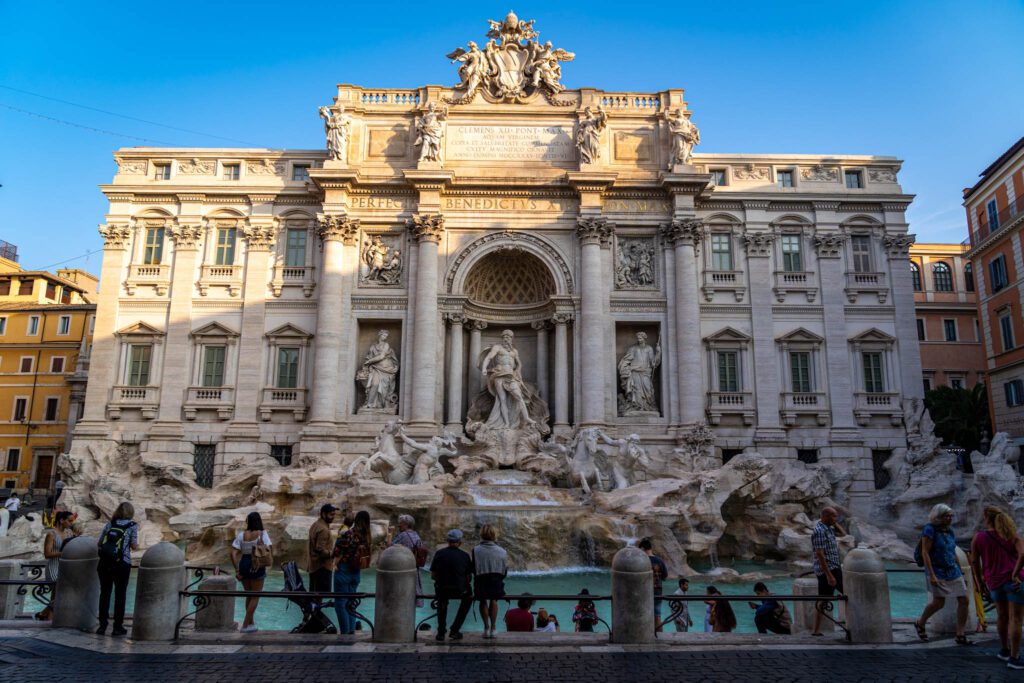
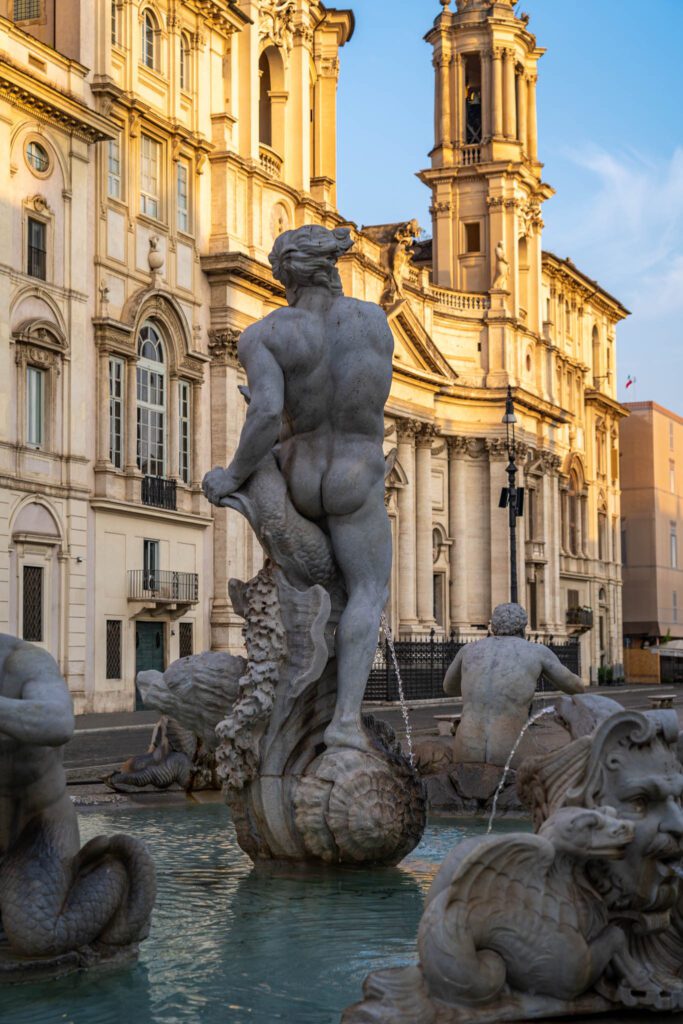
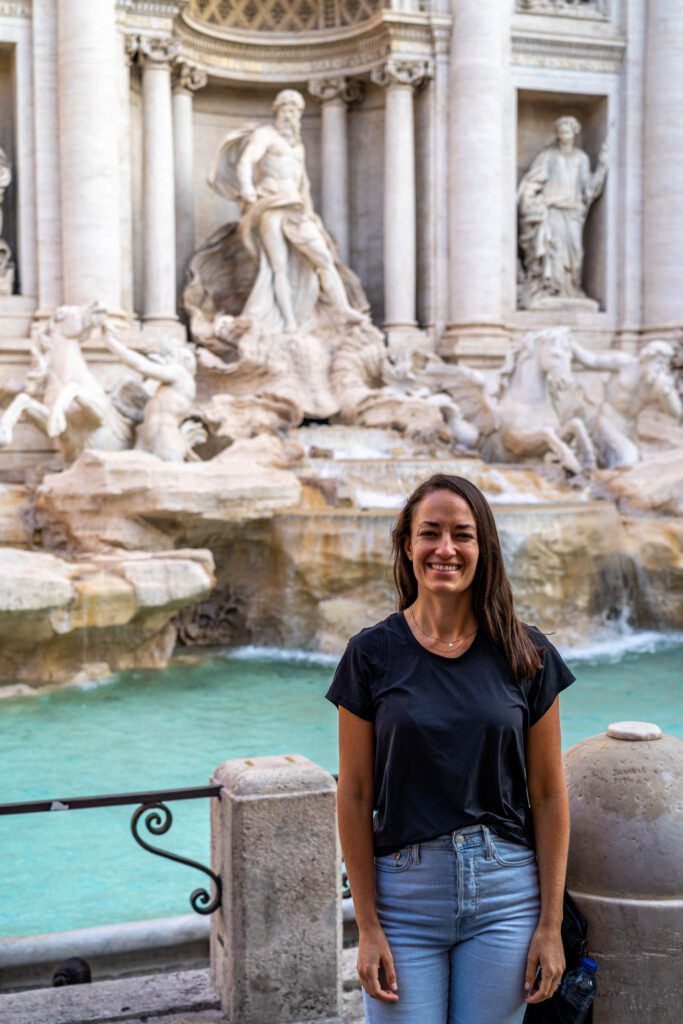
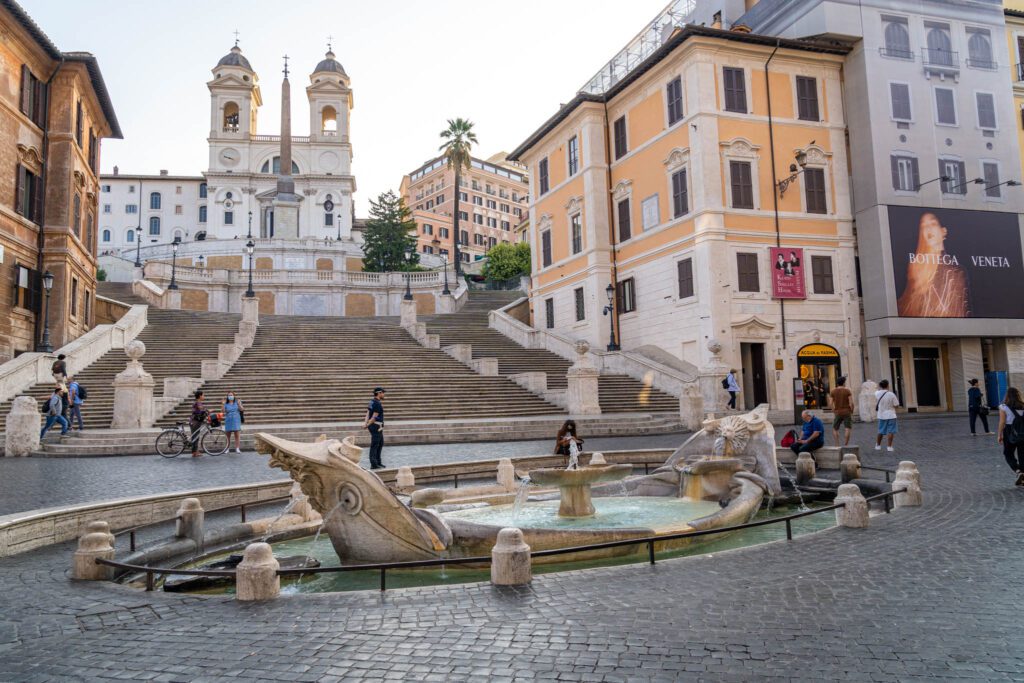
The Borghese Gallery and Gardens
Spend the afternoon exploring the best green space in the city – the Villa Borghese – and experiencing the only art museum (unless you count the Vatican Museums, I suppose) on this Rome itinerary, the Borghese Gallery.
Tickets for the Borghese Gallery are notoriously hard to get because of the extreme limits on people allowed inside at a given time, so book your visit as early as possible. Only 360 people are permitted into this exclusive art gallery every day.

We recommend you pre-book tickets as soon as humanly possible so that you have a chance to experience what we think is the most interesting museum in Rome (sorry, Vatican). You can do so here.
Alternatively, if you’re interested in taking a deeper dive, grab a spot on the excellent Borghese Gallery Tour with Take Walks. It might seem expensive, but you’ll get to experience masterpieces, most notably by the swashbuckling painter Caravaggio (his spine-tingling David with the Head of Goliath is housed within), with all the context and details you’ll want to have to truly appreciate what you’re looking at.
We always do tours of art museums after some great experiences at the Prado Museum in Madrid and the Uffizi Gallery in Florence, and highly recommend it if you’re, like us, not really an art gallery kind of person.
The stories behind the artists and paintings that an expert brings to the table really give you a deeper, richer experience, and help you focus on the important things in a huge museum full of amazing art.
The Villa Borghese is the epicenter of one of Rome’s most lovely parks. If you’re feeling lazy, grab a seat here under the trees and just watch the world go by. Don’t miss the Temple of Asclepius and the lake, which was our favorite part.
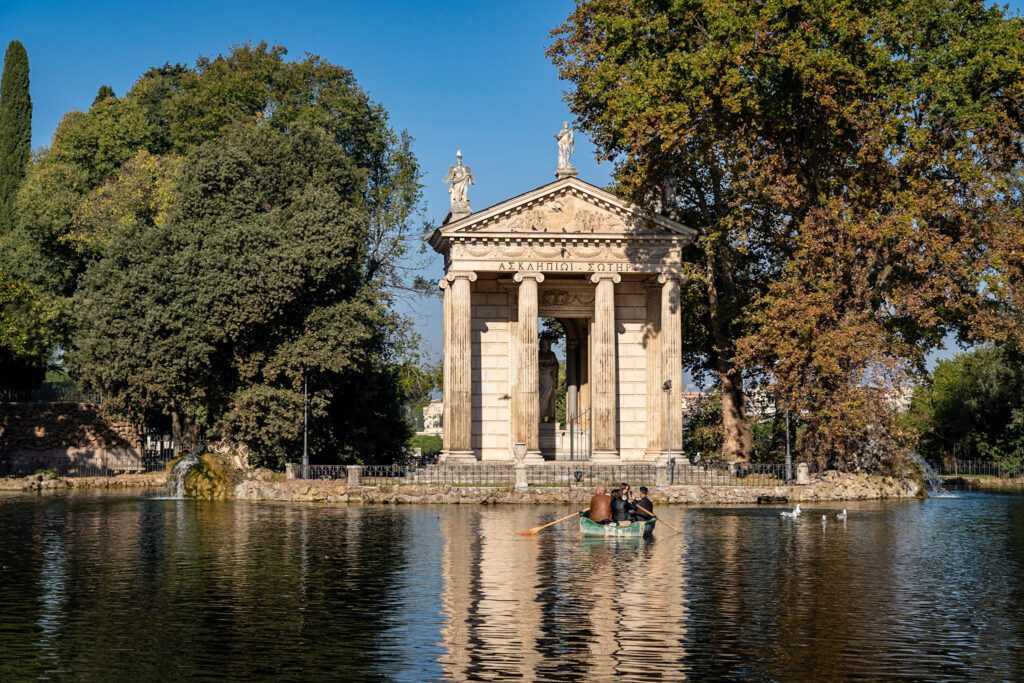
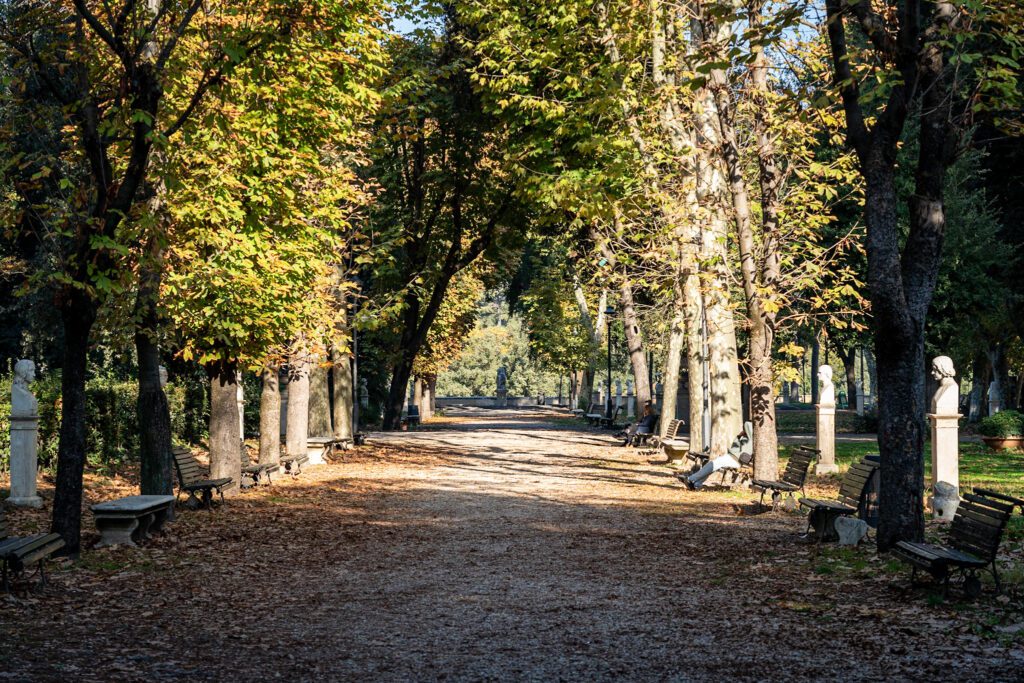
Choose Your Own Foodie Adventure
Diving into the food culture in places we’re visiting is one of our favorite aspects of traveling, and we try to include a food tour, cooking class, or market tour in most places we visit.
Unfortunately, the reality is that because Matt has Celiac Disease and can’t have even a speck of gluten without being sick for days, a food tour or cooking class wasn’t in the cards for us.
HOWEVER. That does NOT mean it shouldn’t be for you! We’d highly recommend it because it gives you a local’s perspective on the city’s food scene – what and where to eat and drink – and you get to connect with fellow travelers and try some amazing food.
Here are some options for you, split between food tours and cooking classes. Our bias is to do a cooking class, because we LOVE to cook, but we also enjoy a good food tour.
Option 1: Learn to Cook Italian Food with a Cooking Class
We’ve done all sorts of cooking classes around the world (read about our cooking class in Mexico City here), and while the gluten-filled nature of Italian food made it nearly impossible to do one in Rome, that doesn’t mean you shouldn’t.
Here are four cooking classes that would definitely be on our list if, you know, Matt could eat gluten.
- Handmade Pasta Class at the Pantheon: You’ll get a brief overview of Roman cuisine before diving in, where you’ll learn how to make two traditional kinds of pasta, along with multiple sauces. And, of course, you get to eat it. Vegetarians welcome.
- Handmade Pasta & Roman Sauces with Riccardo: We love experiences that take us to real people’s homes, in neighborhoods where most tourists don’t make it to. This is that. Join Riccardo – who was born and raised in Rome – in his family home where you’ll make handmade pasta, classic sauces like carbonara and cacio e pepe (our two favorites), and get to connect with the food culture in Rome in a really special way. Plus, wine, obviously, because this is Italy. Vegetarians welcome.
- Handmade Pasta with Grandma: Every culture has the phenomenon of “grandma cooks best,” with classic family recipes passed down from nonna to nonna, and unsurprisingly Italy is no different. You’ll make ravioli, fettuccine and farfalle – all from scratch – in their family home. Note that this tour is a ways outside of Rome (you meet here) so you’ll need to find your way there and back on the train. Vegetarians welcome.
- Pasta-Making Class – Cook, Dine & Drink Wine With A Local Chef: Hosted by Walks of Italy, which we’ve already mentioned is one of our favorite tour companies in Italy, you’ll get a full rundown of handmade pasta, along with aperitivi and prosecco beforehand, and gelato for dessert. The class takes place in Trastevere. Vegetarians welcome.
Option 2: Dive into Rome’s Food Culture with a Food Tour
Here are some food tours that caught our eye though, sadly, we also skipped these because of the whole gluten and cross-contact issue.
- Hidden Rome Food Tour in Trastevere with Dinner and Wine: Explore Trastevere – our favorite neighborhood in Rome – through the eyes of a local foodie. You’ll simultaneously taste amazing food from places that you wouldn’t have discovered on your own, and also get the background and context for how that food came to be a staple in Rome. Plus, wine and limoncello along the way! This tour combines the history and cultural aspects with great food, which is what we usually look for in a tour.
- Twilight Local Food and Hidden Places: A local born and raised, Selene and her team will take you on a tour-de-Rome’s best food. Along the way, you’ll learn about the history and culture of Rome. Followed by pizza al taglio and carbonara, among other delectable tastings. This tour covers the Centro Storico, mostly.
- The Roman Food Tour in Trastevere: This tour, which covers Prati, the neighborhood to the north of the Vatican, includes a tasting of meats and cheeses and the best pizza al taglio in Rome (which we already featured above in the Vatican section…).
- Taste the Best of Rome (Evening Tour): 25 tastings over four hours – so you’ll want to show up hungry! You’ll meander through Prati, stopping at five locally owned spots to try a variety of delicacies from truffles, to meats and cheeses, and more.
Day 4: Exploring Two of Rome’s Best Neighborhoods
On your last day in Rome, spend the day exploring two of Rome’s most interesting neighborhoods – the ever-popular Trastevere, full of bohemian charm with cobblestone streets and ivy-adorned buildings, and grittier Testaccio, which we like because it feels like real people actually live there (and the food scene is great, too).
A Morning Walk Above Trastevere

We think that Trastevere is best in the afternoon and evening, when the activity spills out into the cobblestone streets and charming piazzas.
However, there is a great market at Piazza di S. Cosimato (here on Google Maps) where you can find fresh produce, meats, cheeses, and other products perfect for people who have a place with a kitchen and are looking to do some cooking.

The real reason to head to Trastevere in the morning is to tackle one of our favorite walks in Rome, which we sort of accidentally discovered on one of our last days in Rome on our latest trip.
The walk takes you up the hill behind Trastevere to Belvedere del Gianicolo – where you’ll find a great view over the city – and then back down the other side.
Along the way, there are some really good explanatory panels that describe the historical importance of this area during Italy’s struggle for independence in the mid-19th Century.
Giuseppe Garibaldi, an Italian general during the period immediately before the unification of Italy, is considered to be one of the most important figures in modern Italian history, and there was a battle on this hill above Trastevere that was key in establishing Italy’s independence.
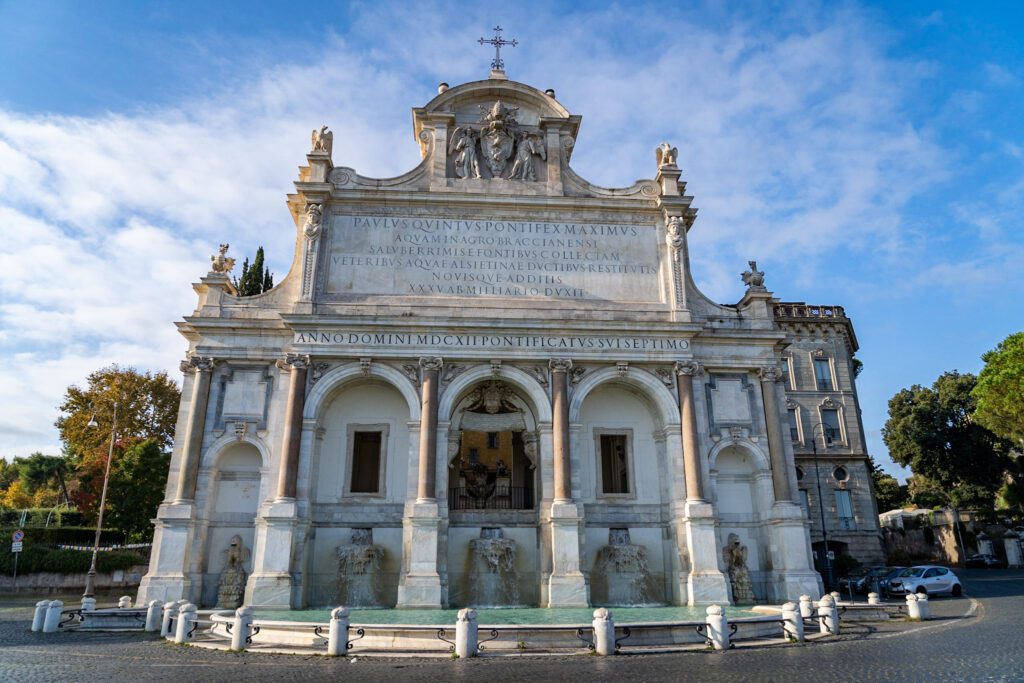
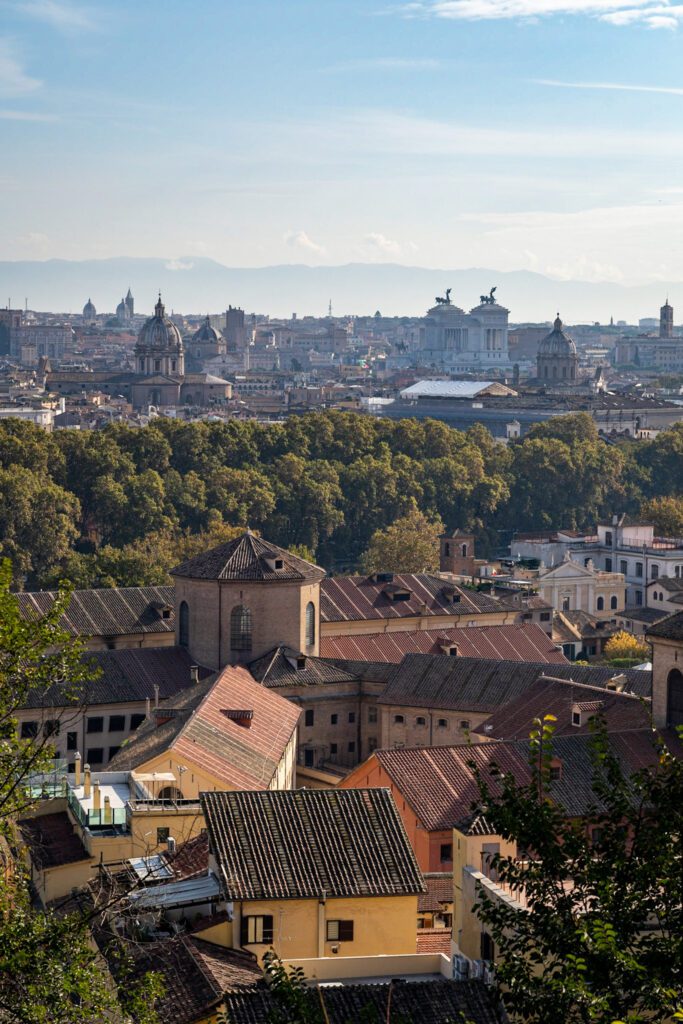
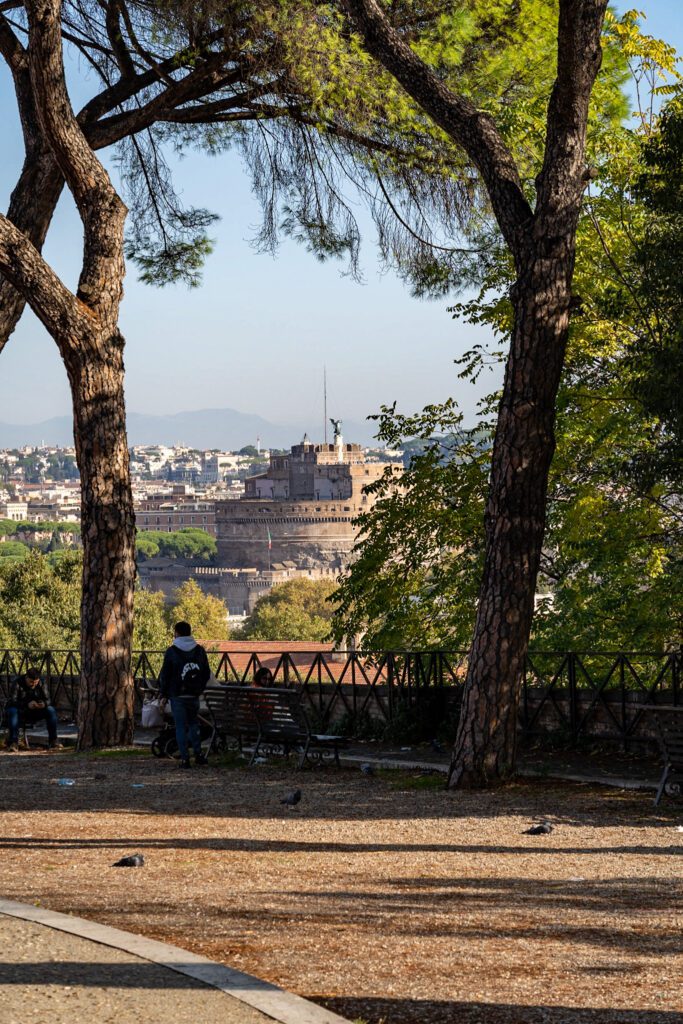
Though, it should be said that the Italian Republic he fought to establish was short-lived, and came back under a new name and brand a decade or so later, which is what has remained to this day.
There’s a statue of him in the middle of the plaza at the Belvedere del Gianicolo.
Here’s a map of the route, and the stops we’d recommend, which ends at Roma San Pietro, where you can catch the train out to Testaccio, the other neighborhood you’ll be exploring today.
Testaccio

A contrast from Trastevere and the rest of Rome’s historical center, the first thing we noticed about Testaccio is that it feels like real people live there.
A neighborhood that, 20 years ago (even less, really) was full of warehouses is today one of the best neighborhoods for foodies in Rome.
To get to Testaccio, grab the regional train from Roma San Pietro to Roma Ostiense, which should only take about 20 minutes and leaves you with a few minutes walking into the heart of the neighborhood.
It costs a couple of Euros per person – buy tickets from the machines at the station, and be sure to validate them before boarding the train.
The first thing to know about Testaccio is that it’s a great food neighborhood.
The food scene is centered around Mercato Testaccio, a big food market that’s roughly half stands selling produce, meat, and cheese, and half stands selling ready-to-eat food (plus some other stands selling random knick knacks and/or shoes). This is where you should have lunch.
It’s not overrun by tourists. It’s not wildly overpriced for what it is. It’s a place where locals go to shop and eat. If you’re interested in going deeper, look at this Testaccio Food Tour.
Here are some other places to check out in Testaccio:
- Tram Depot: A lovely outdoor spot to grab coffee and a pastry or two in the Italian sun. It’s a former tram, now refurbished and serving up good coffee to mostly locals (we were the only tourists there as far as we could tell).
- Non-Catholic Cemetery: When Rome was still a devout Catholic city, the remains of protestant foreigners weren’t permitted to be buried in the regular cemeteries alongside the Catholic citizens. Instead a few non-Catholic cemeteries sprung up to accommodate them and the one in Testaccio is one of the most famous. Remains of Percy Shelley and John Keates can be found buried here. There are also some great views of the Piramide di Caio Cestio, an Egyptian-style pyramid in the middle of Rome, commissioned by a rich Roman guy in the 1st Century B.C.E. that still stands today.
- Volpetti Salumeria: A popular market selling all manner of meats, cheeses, preserves, baked goods, and wine. It is open everyday and perfect for grabbing picnic food to enjoy while exploring Rome. Mingle with the locals as they go about their daily shopping to purchase the ingredients used in real Italian cooking.
An Evening in Trastevere
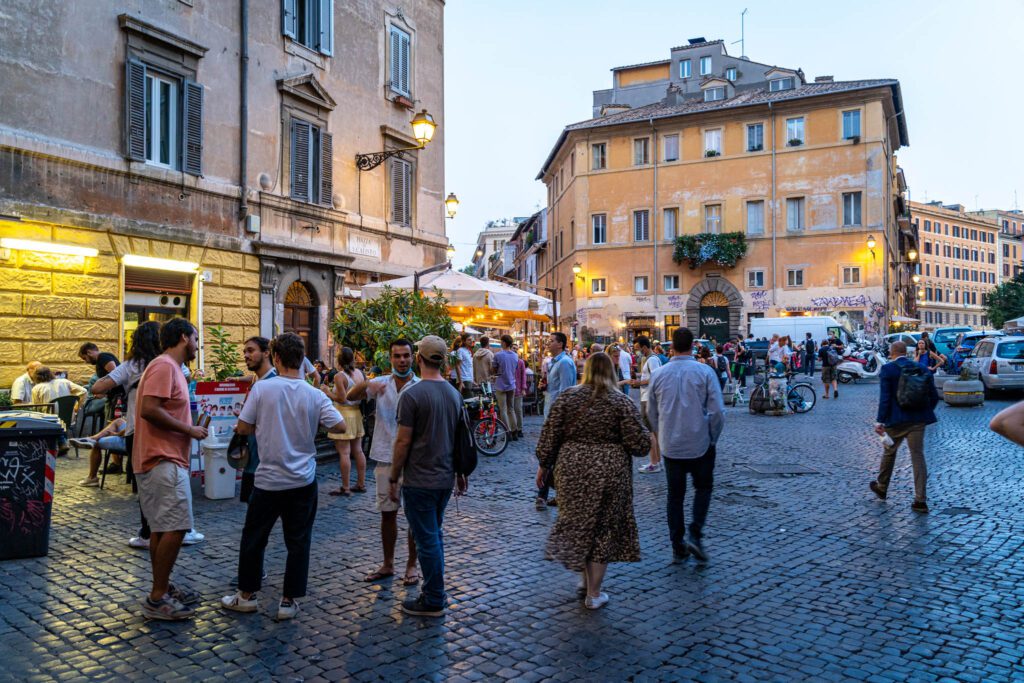
For your last evening in Rome, return to where you started the day – Trastevere – and explore the neighborhood at its best, which is undoubtedly when the sun starts to set over the Tiber.
We don’t have much of an agenda for you here – we think the best thing to do is to wander the streets and soak in the atmosphere. Did we mention that we LOVE Trastevere and we think it’s the coolest place to stay in Rome? We did? Oh, okay, cool.
While we don’t have an agenda, we DO have some recommendations for you to start your exploration.
Don’t miss the Basilica Santa Maria, a beautiful church in the center of the neighborhood filled with gold mosaics by Cavallini. This is one of the prettiest and most underrated churches in Rome – though you wouldn’t really know it from the façade – so it’s a must see in this area.
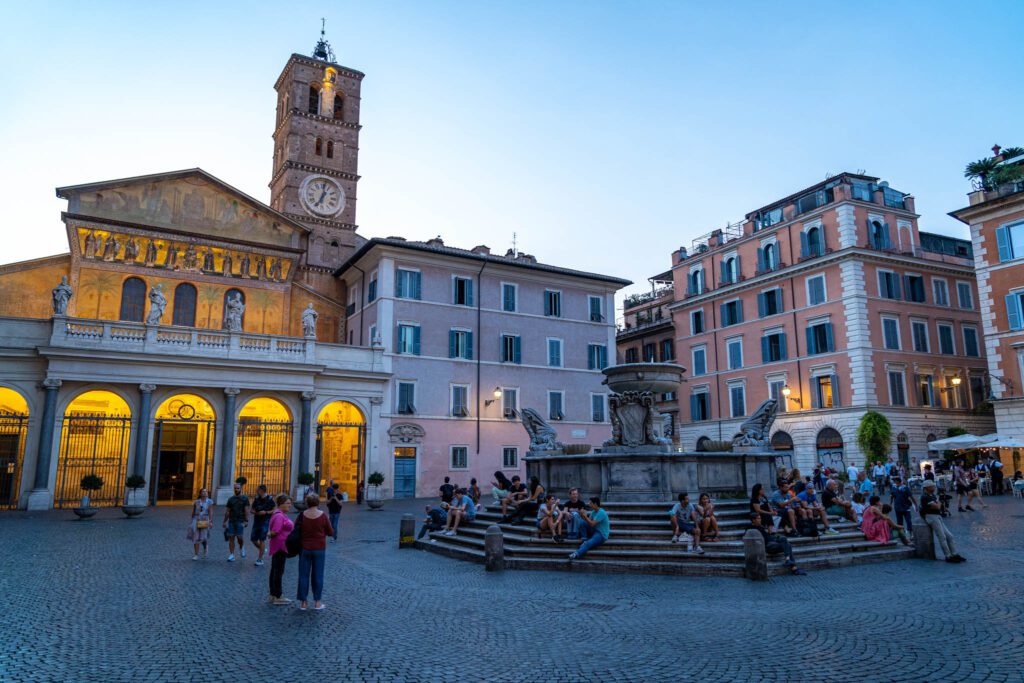
The square in front of it is a meeting place of sorts so is an amazing place to sit and people watch by the fountain.
The other thing you should know about Trastevere is that it has amazing nightlife. Trastevere is one of the liveliest neighborhoods in Rome packed with little bars and trattorias that stay open to the early hours.
There are no clubs here but plenty of small wine bars and craft beer to sip on until the first light of dawn. In summer, bars and restaurants spill out into the streets with tables and chairs outside to enjoy the long sunlight hours.
We like Mama Eat for dinner because they have great gluten free options, and Freni e Frizoni was recommended to us by both a friend and the host at our hotel, though we found it to be expensive and full of tourists (though the spritz was good and the location is great).
Les Vignerons is an amazing little wine and beer store run by a very passionate man (we had a small disagreement, exacerbated by my terrible Italian, about gluten free beer) that is perfect for picking up a bottle of wine, beer, or – and this was a surprise to us – cider! Highly recommend it if you’re looking for a place to buy wine or beer.

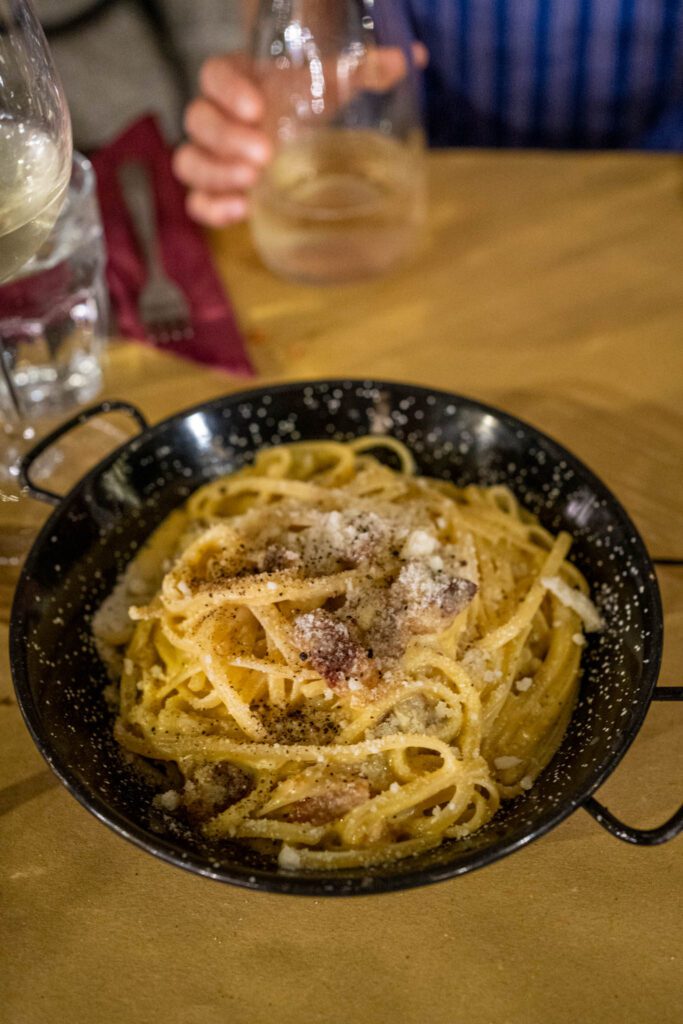
What to Do with Less Time in Rome: Planning a Shorter Rome Itinerary
If you have less time in Rome, you could either try and fit the same amount of things to do in a shorter time period, or you could be more selective about what to do and see, and save the others for a later trip.
We’d recommend the latter approach, which is generally how we approach travel. Pick a few sights, go deep on those, and save the rest for another visit.
For each of these itineraries, you can use the relevant sections in the detailed itinerary above to help you figure out the logistics around each of the sites mentioned.
What to Do with One Day in Rome
If you only have one day in Rome, I hope you’re ready for a whirlwind. If you come to Rome and it’s your first time, you’re going to want to see the Colosseum, the Vatican, and the Centro Storico.
Fitting all three of those sights in a single day is going to be exhausting, and it’s exactly the kind of travel that we don’t usually recommend because it’s just running from place to place without the time to truly experience the place you’re exploring.
But, if you only have one day in Rome, here’s how we would spend it.
First, do a morning tour of the Colosseum and Roman Forum.
Afterwards, have lunch in the Centro Storico (we’d recommend Antico Forno Roscioli) and get gelato at either Fatamorgana or Grom. You can also try to fit in an authentic Italian espresso-at-the-counter experience at Tazza d’Oro too.
After lunch, do the walk from Campo de’ Fiori to the Spanish Steps, passing by Trevi Fountain and the Pantheon along the way.
In the late afternoon / early evening, do a tour of the Vatican at closing time, when it’s much more peaceful. End with dinner in Prati or Trastevere.
Another option would be to do a full day tour of Rome with Walks of Italy, which includes skip-the-line tours of both the Vatican and Colosseum.
What to Do with 2 Days in Rome
If you have two days in Rome, spend it on four main things: the Colosseum and Forum, the Vatican, a walk through the Centro Storico, and an evening in Trastevere.
Spend your first morning taking a guided tour of the Colosseum and Roman Forum, which will give you a richer experience and help you understand the context behind what you’re looking at. Have lunch in Monti before heading to the Centro Storico and walking from Campo de’ Fiori to the Spanish Steps, ending at Piazza del Popolo. Head back the way you came and get some
On your second day, do an early morning tour of the Vatican, head up to admire the view from the top of Castel Sant’Angelo, then head to Trastevere for aperitivo, dinner, and drinks.
What to Do with 3 Days in Rome
With 3 Days in Rome, follow the full itinerary above as written with one change. Cut day four, and spend the evening of day one in Trastevere instead.
More Time? Here are Some Additional Things to Add
If you have more than four days in Rome, there’s still plenty to do and see in the Eternal City. We spent 10 full days in Rome on our latest trip, and we were still finding new things to do and see on the last day (and we didn’t even do the Vatican or Borghese Gallery since we’d already done them before).
One thing we would NOT recommend is a day trip to Pompeii. It is just way too far to go in a day – you’ll need to travel about six hours when it’s all said and done. You need at least 1-2 days.
The Catacombs: Take a tour of the Capuchin Crypts to get into the dark history that lies under Rome’s streets.
A Day Trip to Tivoli: Every major European city seems to have a palace somewhere nearby, built by someone rich at some time in history. For Rome, that’s Tivoli, built by Emperor Hadrian. It’s probably the best day trip from Rome. Here’s a guided tour to get there and back in about half a day.
Pasta / Wine in Frascati: Get out of the city for an evening and head out to nearby Frascati, a well-known wine region in Lazio, for a cooking class / wine tasting extravaganza.
Wine tasting near Rome: One thing we loved about our trip to Italy is trying alllll the different Italian grape varietals! At home, we really get only a handful of grapes. In Italy, each region has their own unique grapes, and it’s fun to try them all. For Rome, Frascati is the place to go for wine tasting, and makes a fantastic day trip. The best way to do it without a car is a guided tour – here’s a tour that gets stellar reviews.
The Best Time to Visit Rome
There’s no hard and fast rule about the best time to visit Rome. The Italian capital is blessed with four distinct seasons.
Our overall pick would be the fall, but each quarter of the year offers its own unique delights.
- Summer – High season in Italy. Rome is super busy and very hot. Hotel prices skyrocket and there are long lines for many of the main attractions. The bonus is that you get to see the city buzzing with life and the weather is usually sun, sun, and just a little extra sun for good measure.
- Fall – Our favorite time in Rome. Seriously, we don’t think you can beat this city in September and October. There’s just something so lovely about the changing color of the cork oaks along the Tiber River and the balmy evenings. The only downside to autumn is that there’s the chance of some rainfall.
- Winter – Rome takes on a brooding, mysterious air in the winter. There can sometimes be freak snow storms, and we’ve seen frozen fountains on Piazza Navona in the past. Hotel rates tend to be cheaper in winter and there’s way fewer people crowding the main attractions. You’ll need the thermals and a coat though!
- Spring – Like fall, spring is downright stunning in Rome. There can be quite a bit of rainfall, but that’s balanced out by the flower blooms in parks like Villa Borghese and Doria Pamphili. May is another sweet spot for crowds because the summer rush hasn’t started quite yet.
Getting to Rome
Rome is one of Europe’s major capitals, which means it’s really well connected to other spots around the world by both air, road, and rail. Getting in shouldn’t be hard, no matter if you’re starting in New York City or London.
Flying to Rome
Rome has two airports: the Leonardo da Vinci International Airport (FCO) in Fiumicino and the Rome Ciampino Giovan Battista Pastine Airport (CIA) in Ciampino.
The first is the capital’s main international hub. That’s where you’ll touchdown from long-haul flights from the US, but also on cross-Europe flights with premium carriers like British Airways or Lufthansa.
Ciampino is primarily an arrival point for low-cost airlines like Ryanair and EasyJet, which are worth knowing about if your trip to Rome is part of a continent-wide adventure.
Getting into the city from both airports is a cinch:
- From Fiumicino Airport (the Leonardo da Vinci International Airport): Take the train. It’s pricier than the bus at around $18 each way, but far faster (30 minutes from A to B) and won’t slow down when traffic gets bad – and it can get really bad in Rome! The train is called the Leonardo Express. It leaves from the station within the airport (follow the train signs) and arrives at Termini Station.
- From Ciampino (Rome Ciampino Giovan Battista Pastine Airport): Sadly, there’s no direct train route from the airport in Ciampino to the center of Rome. The buses are pretty reliable, though. Take the service with either Terravision or SITBus. They cost up to $9.50 per person, each way, and take 50 minutes to arrive at Termini Station in the center.
Don’t be tempted to use Uber to get to your hotel from the airport. Rome is a taxi culture. Only the deluxe Uber Black cabs are offered on the app. A taxi from either airport to the center should cost around $50.
Arriving by Train
Rome is the hub of a highly efficient Italian railway network that can take you south all the way to Sicily via the pizza mecca of Naples, and north to Vienna and Munich on high-speed and overnight trains that go through the Alps.
There are also many shorter, slower trains – known in Italy as Regionale trains – that connect the capital with surrounding towns in regions like Lazio, Tuscany, and Umbria (all of which are worth exploring if you have more time in Rome).
These days, virtually ALL trains to Rome come into the huge Termini Station. We’ve always loved arriving there. It’s a feast for the senses. Everywhere you look there’s something going on, from business travelers clinking espressos to huge locomotives purring to a stop.
Termini Station is also a convenient arrival spot. It’s got a direct link to the Rome Metro network, and there’s a major bus interchange right out front.
It might be worth adding a warning: The area immediately around Termini isn’t the most welcoming in the city. It can feel a tad rough and gritty. Keep your wits about you if you’re arriving late there and don’t let it put you off the town right away!
Getting Around Rome
Rome was founded way back in 750 BC. In the 2,700+ years since then it’s been expanded and altered and built on more than most cities around the world. So, it should hardly come as a surprise that it’s not the easiest town to navigate.
The streets can be narrow and winding, particularly in the Centro Storico (the medieval core of Rome). There are even roadways that have to work around ancient monuments – we remember waiting 30 minutes once to pass under an arch in an ancient aqueduct!
The upside? Walking might just be your best bet.
Rome isn’t small but it’s not massive a la London or Paris. Many of the main areas you’ll want to see as a first-time visitor on a 4 day trip to Rome are all linked by paths along the Tiber River. What’s more, doing Rome by foot is a joy in its own right.
You just never know when you’ll stumble upon an imperial arch built by one of Rome’s famous emperors, or an inviting little vinoteca beneath the stone pines.
The Rome Metro
The ever-expanding Rome Metro currently has three lines. They all intersect at Termini Station. Really, the Metro is for commuters who want to reach the suburbs of Rome, because the main lines extend very far to the east and the north of the town.
That said, there are a few stops near the major attractions – Circo Massimo, Repubblica, Spanga, Colosseo – that you might make use of.
Buses
The bus network in Rome is very extensive. It covers everywhere the Rome Metro doesn’t and even doubles up to offer alternative routes to popular spots like the Colosseum and Vatican City.
At last count, there were 338 individual bus lines running throughout the Italian capital. The main interchange is just out the front of Termini Station, but you can catch buses from anywhere along the routes they run. Look for the map of where you can go at the individual stops.
Always remember to validate your ticket at the crunching machines on the buses – this is a common mistake among first-time travelers to Rome and often ends in a fine!
Trams
Rome’s above-ground trams connect the major suburbs to the east and west. For that reason, they might not be of such great use to visitors looking to explore the heritage-rich heart of the capital (where the main sights are).
However, there are some tram services in Rome that can be handy, like the one from Trastevere to Argentina (just south of the Pantheon) or the Colosseum, for example.
Tickets for Public Transportation
All the tickets for all the different types of public transportation in the Eternal City are linked. Buy one and you can travel on trams, buses, and metros to your heart’s content. There are a variety of fare options:
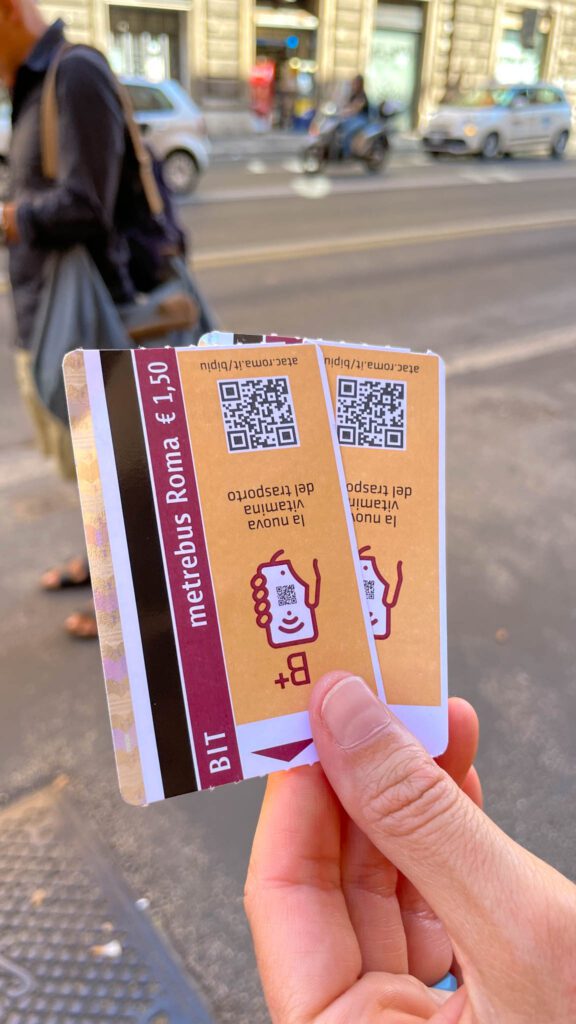
- 100-minute tickets (€1.50/$1.80) – Valid for any public transportation in Rome for 100 minutes with unlimited transfers.
- 24-hour ticket (€7.00/$8.35) – Valid for any public transportation in Rome for 24 hours after the moment you validate.
- 48-hour ticket (€12.50/$15) – Two days of unlimited travel on any public transportation from the moment of validation.
- 72-hour ticket (€18/$21.50) – Three days of unlimited travel on any public transportation in Rome from the moment of validation.
All tickets can be bought at the kiosks by the stations (there are lots around Termini Station) or from machines on the Metro platforms. Make sure you validate tickets at the punch stations before use!
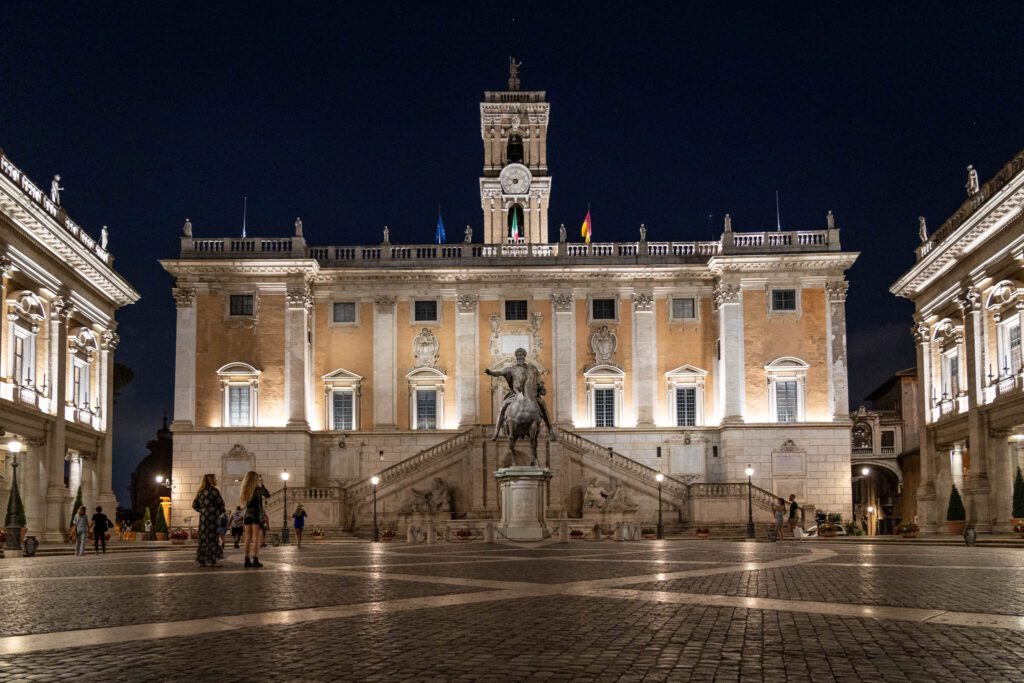

I just spent the last hour reading this blog and OMG, it is wonderfully written and EXACTLY what I was looking for. I am thinking of planning a trip to Rome next March and I am SOLD after reading this. You wrote in great detail, to the point where I could see myself there. I’m looking forward to planning this trip and I soooo appreciate this blog. Keep it up!!
What a great blog, my very first research for our (traveling with my husband) upcoming trip to Rome in about 20 days. We just returned from Milan after a 2 month trip to northern Europe in late summer. Now heading to Rome via Milan and this was the perfect information I was looking for. Though we are traveling in November, am sure Rome might not be as cold as Philly. Enjoyed reading this and will definitely keep this as our guide to our 4 day adventure. Looking forward to reading about your other destinations. I read about you both and it seems like I was reading about me n my husband (yes we do lot of research and of course the excel spread sheet, google mapping, travel folders etc). We are big travel enthusiasts and travel extensively, yes 3 months at times too, just too lazy to write up a beautiful blog like yours. Have done many countries and yet always feel there is till so much more to explore. So keep on traveling and sharing your experiences. Thank you once again.
Thanks for the kind words! We put a lot of time and effort into it, and we’re glad you found it both useful and entertaining (the balance we’re always trying to strike). We do love a good excel spreadsheet when we’re planning. Cheers!